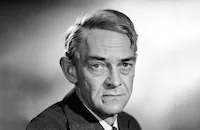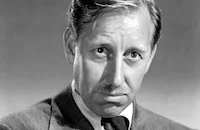The Light in the Forest
Brief Synopsis
Cast & Crew
Herschel Daugherty
Fess Parker
Wendell Corey
Joanne Dru
James Macarthur
Jessica Tandy
Film Details
Technical Specs

Synopsis
In 1764, after an outbreak of Indian attacks on white settlers, Col. Henry Bouquet marches the 1,500 soldiers of the Royal American Regiment one hundred miles down the Ohio River from Fort Pitt, Pennsylvania. Cuyloga, chief of the Delaware Indians, presents a belt to Col. Bouquet, saying it is the will of the Great Spirit that there be peace. When the Col. castigates Cuyloga for murdering settlers, Cuyloga contends that the Paxton Boys, vigilantes from the Paxton township, attacked their village first and murdered helpless Indian women and children, scalping them and committing indecencies. After Bouquet promises that no white man will settle on the Indians' lands and that there will be no further attacks, Cuyloga agrees to return all the white prisoners. When Half Arrow, the chief's son, asks his friend, True Son, a white teenager captured as a child and raised by Cuyloga, if he will leave, True Son defiantly asserts that he is an Indian, not a white. The council of chiefs votes to respect the existing treaty, however, and Cuyloga tells all the white children that they must leave. Along the march to Pennsylvania, True Son attempts to kill himself by eating a mandrake root, but scout Del Hardy, the Col.'s interpreter, who lived among the Delaware himself as a child, makes him spit it out. After Half Arrow brings True Son a message from Cuyloga telling him not to fight back, True Son says he will bear his disgrace like an Indian. When True Son meets his real parents, Harry and Myra Butler, he refuses to speak English. Myra is stern with him, insisting that he realize he is not an Indian and demanding that he speak his English name, Johnny, and he finally gives in. Col. Bouquet, sensing that Johnny's presence in the community may stir up conflicts with the Paxton Boys, asks Del to remain at Fort Pitt. Del learns that the commander of the Paxton Boys, John Elder, is considered to be a fine man, but that he oversees some hotheads. At a party in Johnny's honor, Del meets Elder and his daughter Milly. Wilse Owens, Myra's brother, who is one of the "hotheads," taunts Johnny by calling the Indians "devils." When Johnny denies that Indians have attacked white women and children, Wilse introduces his indentured servant, Shenandoe Hastings, a teenager who testifies that her mother, father and little sister were scalped. Wilse takes pride in the Paxton Boys' massacre of Indians and slaps Johnny when the boy calls him a butcher. Del responds by threatening Wilse. As Myra begins to get to know her son, she asks him to teach her the Delaware language. When Johnny sees that Wilse and his friends are using for target practice a dummy dressed in his Indian clothes, he runs to the dummy. Del stops Wilse from shooting at Johnny by knocking his gun away, and after challenging Wilse to a shooting contest, shoots the weather vane off Wilse's barn. As Del gets to know Milly, he admits he might be willing to leave the army to become a farmer. After Johnny talks to Shenandoe about the deaths of her family, he suspects the perpetrators were Wyandots. At a dance, when Johnny is told to give a ring he finds in a piece of cake to the one he likes most, he presents it to Shenandoe. He is told to kiss her, but he says Indians do not kiss. Outside, Wilse, who earlier tried to grab Shenandoe in a barn, hits Johnny, warning him to keep his "snake eyes" off her. Johnny vows to Shenandoe that he will kill Wilse, but she goes off exasperated, fearing he will grow up to be like Wilse. Del soon leaves to rejoin Col. Bouquet, but promises to stake Johnny's claim of Piney Woods Mountain, a beautiful wooded area by a waterfall, which Johnny and Shenandoe found one day. After Del goes, Johnny proposes to Shenandoe and they kiss. In the midst of their embrace, gunshots are heard, and Johnny finds Half Arrow, who has come with a message that tribesman Little Crane has been killed for trying to visit his "white squaw," who had been returned to the whites because of the treaty. When Wilse finds them together and fights them, Half Arrow is about to take Wilse's scalp, but Johnny stops him. Afraid he will be killed if he stays, Johnny returns to the Delaware. The tribe's council decides that twenty scalps will avenge Little Crane's death. Meanwhile, Del tells Col. Bouquet of his decision to leave the army and become a farmer, but he agrees to help stop settlers from taking lands from the Indian side of the Ohio. After Del and his men find a burned village and signs of the Delaware war party, Little Crane's brother, Niskitoon, reports to Cuyloga with fifteen scalps, including some children's, which saddens the chief. When they see a settlers' boat approach, Niskitoon gives white men's clothes to Johnny so that he can lure them closer. Dressed as a white man, Johnny tells the settlers he is starving. Before they reach him, however, Johnny warns them it is an ambush, and they escape unharmed. In the Indian camp, as Niskitoon is about to burn Johnny, Cuyloga takes the blame for Johnny's treachery and rules that Little Crane's death is avenged. He cuts Johnny loose and sadly tells him to go and that if they meet in battle he must kill him. Del finds Johnny, who disconsolately says that he now has no people. Del compares Niskitoon and Wilse, and says that there are good and bad on both sides. They return to Fort Pitt, and when Wilse calls Johnny a savage beast, Del blames Wilse for the killing that led to the death of the fifteen settlers. As the whole town watches, Johnny and Wilse have a fistfight. With instructions from Del and encouragement from Shenandoe, Milly and Harry, Johnny beats Wilse, who afterward smiles and says Johnny has now become white. As Milly hugs and kisses Del, Shenandoe and Johnny run off to the waterfall.

Director
Herschel Daugherty
Cast
Fess Parker

Wendell Corey

Joanne Dru

James Macarthur

Jessica Tandy

John Mcintire

Joseph Calleia

Carol Lynley
Rafael Campos

Frank Ferguson
Norman Fredric
Marian Seldes
Stephen Bekassy
Sam Buffington
Iron Eyes Cody
George Keymas
Eddie Little
Joyce Vanderveen

Gloria Castillo
Robert Anderson
Jack Lorenz
Walter Sumner
Kevin Hagen
Kay Kuter
Myrna Sahey
Pat Brady
Jack Hill
Nancy Crawford
Noralee Norman
Don Washbrook
Harriet Sumner
Will J. White
Bernie Selman
Crew
Carlos Albert
William Angelo
Tom Bartholomew
Roy Bolton
Jack Boss
B. Brady
Matt Bruttig
Ruth Burch
Gertrude Casey
Charles Chrisman
Carroll Clark
Iron Eyes Cody
John Collins
Tom Collins
Robert O. Cook
Linda Cross
Jack Cunningham
Walt Davis
Ren Daw
Joe De Angelo
Walt Disney
Walt Disney
Peter Ellenshaw
Peter Ellenshaw
Elmer Ellsworth
Willon Fields
Ellsworth Fredricks
Ann Gardner
James Lester Gear
Gil George
Jack Golconda
Tom Goldrick
D. Green
John Grubbs
V. Hall
Leonard Harris
Virgil Hart
John Holden
Millard Holmes
Bruce Hunsacker
Stanley Johnson
Bill Jones
Chuck Keehne
Ted Kehoe
Knox Kelly
Evelyn Kennedy
Colin Kenny
Esther Krebs
Emile Kuri
Lillian Lashin
Walter Lea
C. Macallister
Fred Maclean
James Mansbridge
Franklyn Marks
Robert Mcgowan
J. Mckinney
Pat Mcnalley
Russell Meeker
T. Morales
Donna Norridge
Yewas Parker
Jack Pennick
Harvey Perry
Cliff Reid
Malcolm Rennings
Ruth Sandifer
Leonard Shannon
Robert G. Shannon
Bill Sheehan
Bill Sheehan
Abe Siegel
Lou Skelton
Fae Smith
Paul Smith
Paul Smith
B. Spencer
Jack Stone
C. Sullivan
R. Terry
Dean Thomas
Hazel Thompson
Captain Thornsberry
Beau Van Den Ecker
A. Vaughn
Lawrence Edward Watkin
Lawrence Edward Watkin
Jack Whitman Jr.
Jack Whitman Sr.
Al Wyatt

Film Details
Technical Specs

Quotes
Trivia
Notes
According to a New York Times news item, although Walt Disney bought the rights to the novel by Pulitzer Prize-winning author Conrad Richter in June 1953, a month after its publication, he did not plan to put it into production until 1957. The New York Times review noted that the ending of the film was changed from the book. Location shooting was done at Massengale Point, TN and along the Tennessee River, about twenty miles from Chattanooga. The Rowland V. Lee Ranch in the San Fernando Valley of CA was used for the Indian village, and the "Piney Woods Mountain" scenes were shot at the Rainbow Angling Club in Azusa, CA.
As noted in news items and publicity for the film, The Light in the Forest was James MacArthur's second film. Disney signed him after seeing his first film, The Young Stranger (see below). MacArthur, the adopted son of Helen Hayes and Charles MacArthur, was a student at Harvard at the time, and his contract stated that he would work only during the summer break from school. The picture marked Carol Lynley's screen debut. Disney signed Lynley, who had been an actress and model since age ten, after seeing her picture on the cover of Life, but she agreed only to a one-year contract.
According to reviews and news items, Iron Eyes Cody, who played the role of "Blackfish" and acted as technical adviser, designed and made over thirty-five costumes for the film with his wife, Yewas Parker. In addition, Cody was said to have translated the Delaware dialogue and helped the cast speak the language. Hollywood Reporter noted that the actors playing Delawares "speak in the language of the Hurons, to which linguistic group they belonged." According to the pressbook, the Penomsquat Indians in Oldtown, ME made a twenty-foot war canoe for the film, which was to go to Disneyland following production. Disney himself came to the Tennessee location for three days, according to news items. The film's premiere at Harrisburg, PA was to benefit community charities.
Variety, in its review, commented, "Like most Disney productions, it is pastoral in quality, almost fable-like in its gentle approach to some basically bitter situations." Hollywood Reporter noted, "Volumes of fan mail praising authenticity have convinced [Disney] that meticulous research has given his studio tremendous prestige in educational circles and this is of real commercial advantage." The film was telecast in two parts on 12 November and November 19, 1961 as "True Son" and "True Son's Revenge" on Walt Disney's Wonderful World of Color.

Miscellaneous Notes
Released in United States Summer July 1958
Released in United States Summer July 1958











